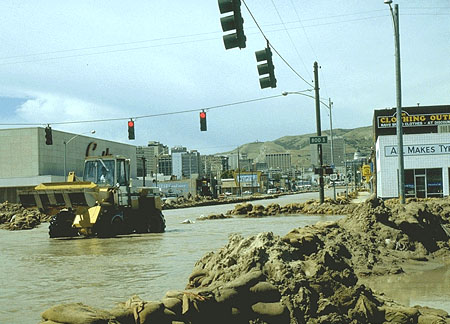Luckily I live on a hill, but neighbors near the river bottom do get flooded.
It's a pretty dry area over here, at least when compared to the Gulf or the NW US Coast, but it does rain hard (just not as often in those other places) during t-storms and it does flood.
Inronically, the biggest floods however, happen on hot and dry days and during early heatwaves. In Spring, say May, the snow can be 8-10 feet deep in the mountains. If an early heat wave hits between May or early June and sends temperatures into the upper 80's or lower 90's, a lot of snow can melt fast and it all comes down the river quick, overspilling the banks and flooding everthing not on a hill.
The worst year was 1983. A quote from the USGS:
The winter of 1982-83 was among the most severe in Wyoming, Colorado, Utah, Nevada, and parts of other Western States since records began. Wet, cold weather with large accumulations of snow continued through April. A record snowpack resulted from the extended winter weather and lingered until May or early June. Temperatures stayed cold longer than normal and when they began to rise, it was a sharp and rapid increase. Several events resulted from these conditions-(1) High-magnitude streamflow, both in terms of volume and maximum discharges, occurred in most of these Western States; (2) the first required use of spillways at Hoover and Glen Canyon Dams on the Colorado River; (3) long-duration flooding along the lower Colorado River; (4) devastating landslides and debris flows in Utah and Nevada; and (5) the highest water level since 1924 in the Great Salt Lake.The flood hit hard here, but at the time I lived in Salt Lake City. It hit there too and we got flooded. Here is a photograph of downtown:

Thistle got hit worse, but luckily it was a small town. The entire town was destoyed and buried under water
165 feet deep and has been a ghost town ever since.
http://www.ghosttowns.com/states/ut/thistle.html





